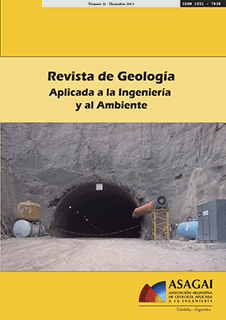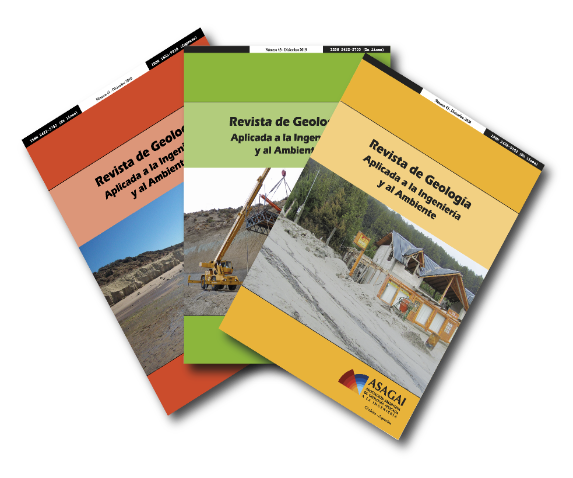Análisis de la actividad de movimientos de ladera mediante láser escáner terrestre en el suroeste de la Cordillera Bética (España)
Palabras clave:
actividad, movimiento de ladera, láser escáner terrestre (TLS), factor desencadenante.Resumen
Para el análisis de de la evolución diacrónica de los movimientos de ladera es necesario conocer su grado de actividad y desarrollo, velocidad, volumen y localización de escarpes y zonas de acumulación o reducción de la masa desplazada. Una de las herramientas más poderosas para la monitorización, caracterización y cuantificación de la evolución del relieve, incluyendo los movimientos de ladera, es la tecnología TLS (Terrestrial Laser Scanning). Mediante esta técnica se puede detectar y cuantificar las variaciones tridimensionales de la morfología de una ladera mediante el tratamiento y análisis de los datos registrados a lo largo del tiempo. Este trabajo presenta la metodología y los resultados obtenidos mediante la combinación de las técnicas TLS y GNSS (Global Navigation Satellite Systems) en la detección y evaluación de reactivaciones y desplazamientos diferenciales de dos deslizamientos localizados en la cuenca del río Guadalfeo al SO de Sierra Nevada (Granada, España) desde 2008 hasta 2010. En el primer deslizamiento (Almegíjar) se ha detectado un desplazamiento descendente de hasta 1,8 m, con un gradiente máximo de 1,04 m/año. El volumen de masa desplazada es de 49090 m3, afectando a una superficie de casi 20000 m2. En el segundo deslizamiento (Borincho), se han detectado desplazamientos descendientes con gradientes comprendidos entre 0,32 m/año y 0,56 m/año, en una zona afectada de 2610 m2. El uso combinado de las técnicas TLS y GNSS ha permitido cuantificar y cartografiar rasgos geomorfológicos de los movimientos de ladera que se consideran de interés para la previsión de la actividad y evolución de dichos movimientos de ladera.El análisis de los datos obtenidos indica que las intensas lluvias caídas entre diciembre de 2009 y marzo de 2010 han actuado como agente activador en los dos deslizamientos estudiados. Se establece el umbral de precipitación necesario para que se inicie la reactivación, comprendido entre 190 mm/mes y 287 mm/mes en el primer deslizamiento y entre 157 mm/mes y 236 mm/mes en el segundo.
Citas
ABELLÃN, A.; CALVET, J.; VILAPLANA, J.M. y BLANCHARD, J., 2010. Detection and spatial prediction of rockfalls by means of terrestrial laser scanner monitoring. Geomorphology, Vol 119: 162-171.
ABELLÃN, A.; VILAPLANA, J. M.; CALVET, J.; GARCÃA-SELLÉS, D. y ASENSIO, E., 2011. Rockfall monitoring by Terrestrial Laser Scanning - Case study of the basaltic rock face at Castellfollit de la Roca (Catalonia, Spain). Natural Hazards and Earth System Science, Vol 11: 829-841.
BORIS, D., 1934. Sur la sphère vide. Otdelenie Matematicheskikh i Estesvennykh Nauk, Vol 7: 793-800.
COROMINAS, J. y MOYA, J., 2008. A review of assessing landslide frequency for hazard zoning purposes. Eng Geol, Vol 102: 193-213.
CROSS, M.,1998. Landslide susceptibility mapping using the Matrix Assessment Approach: a Derbyshire case study. Geohazards in Engineering Geology. Geological Society Special Publication,Vol.15.: 247-261.
CRUDEN, D.M. y VARNES, D.J., 1996. Landslide types and processes. Special Report - National Research Council, Transportation Research Board, Vol 247: 36-75.
CHACÓN, J.; IRIGARAY, C.; FERNÃNDEZ, T. y EL HAMDOUNI, R., 2006. Engineering geology maps: landslides and geographical information systems. B Eng Geol Environ, Vol 65: 341-411.
CHACÓN, J.; IRIGARAY, C.; EL HAMDOUNI, R. y JIMÉNEZ-PERÃLVAREZ, J.D., 2010. Diachroneity of landslides. En: Williams et al. (eds.),Geologically Active, pp. 999-1006., Taylor & Francis Group, London.
CHACÓN, J., 2012. Movimientos de ladera: clasificación, descripción y evolución espacial y temporal. Revista de GeologÃa Aplicada a la IngenierÃa y al Ambiente, Vol 28: 73 – 89.
DELGADO, J.; PELÃEZ, J.A.; TOMÃS, R.; GARCÃA-TORTOSA, F.J.; ALFARO, P. y LÓPEZ-CASADO, C., 2011.Seismically-induced landslides in the Betic Cordillera (S Spain). Soil Dyn Earthq Eng, Vol 31:1203–1211.
DUNNING, S.A.; MASSEY, C.I. y ROSSER, N.J., 2009. Structural and geomorphological features of landslides in the Bhutan Himalaya derived from Terrestrial Laser Scanning. Geomorphology, Vol 103: 17-29.
DUNNING, S.A.; ROSSER, N.J. y MASSEY, C.I., 2010. The integration of terrestrial laser scanning and numerical modelling in landslide investigations. Quarterly Journal of Engineering Geology and Hydrogeology, Vol 43: 233-247.
EL HAMDOUNI, R.; IRIGARAY, C.; FERNÃNDEZ, T.; CHACÓN, J.; KELLER, E.A., 2008. Assessment of relative active tectonics, southwest border of the Sierra Nevada (southern Spain).Geomorphology, Vol 96: 150-173.
FELL, R.; COROMINAS, J.; BONNARD, C.; CASCINI, L.; LEROI, E. y SAVAGE, W.Z., 2008. Guidelines for landslide susceptibility, hazard and risk zoning for land-use planning. Eng Geol, Vol 102: 99-111.
FERNÃNDEZ, P.; IRIGARAY, C.; JIMÉNEZ, J.; EL HAMDOUNI, R.; CROSETTO, M.; MONSERRAT, O.; CHACÓN, J., 2009. First delimitation of areas affected by ground deformations in the Guadalfeo River Valley and Granada metropolitan area (Spain) using the DInSAR technique. Eng Geol, Vol 105: 84-101.
FERNÃNDEZ, T.; IRIGARAY, C.; EL HAMDOUNI, R. y CHACÓN, J., 2003. Methodology for landslide susceptibility mapping by means of a GIS. Application to the Contraviesa area (Granada, Spain). Nat Hazards, Vol 30: 297-308.
FERNÃNDEZ, T.; PÉREZ, J.L.; DELGADO, J.; CARDENAL, F.J.; IRIGARAY, C. y CHACÓN, J., 2011. Evolution of a diachronic landslide by comparison between different DEMs obtained with digital photogrammetry techniques in Las Alpujarras (Granada, Southern Spain). International Symposium on Geo-information for Disaster Management (Gi4DM), 3-8 Mayo 2011, Antalya, TurquÃa.
GOODCHILD, M. F.,1986.Spatial autocorrelation. CATMOG47. Geo Books, Norwich. pp. 56.
GÓMEZ-PUGNAIRE, M.T.; GALINDO-ZALDÃVAR, J.; RUBATTO, D.; GONZÃLEZ-LODEIRO, F.; LÓPEZ SÃNCHEZ-VIZCAÃNO, V. y JABALOY, A., 2004. A reinterpretation of the Nevado-Filábride and Alpujárride Complexes (Betic Cordillera): Field, petrography and U-Pb ages from orthogneisses (western Sierra Nevada, S Spain). Schweizerische Mineralogische und Petrographische Mitteilungen, Vol 84: 303-322.
GUZZETTI F., REICHENBACH P., ARDIZZONE F., CARDINALI M. y GALLI M.,2006. Estimating the quality of landslide susceptibility models. Geomorphology, Vol 81: 166-184.
IAG, 2013. Actividad sÃsmica reciente.Disponible en:http://www.ugr.es/~iag/div.html. Último acceso: abril de 2013.
IRIGARAY, C.; LAMAS, F.; EL HAMDOUNI, R.; FERNÃNDEZ, T. y CHACÓN, J., 2000. The Importance of the Precipitation and theSusceptibility of the Slopes for the Triggering ofLandslides Along the Roads. Natural Hazards, Vol 21: 65–81.
IRIGARAY, C.; FERNAÌNDEZ, T.; EL HAMDOUNI R. y CHACOÌN J., 1999. Verification of landslide susceptibility mapping: a case study. Technical report. Earth Surface Processes and Landforms, Vol 24: 537-544.
IRIGARAY, C.; FERNÃNDEZ, T.; EL HAMDOUNI, R.; CHACÓN, J., 2007. Evaluation and Validation of Landslide-Susceptibility Maps obtained by a GIS Matrix method: Examples from the Betic Cordillera (Southern Spain).Natural Hazards, Vol 41:61-79.
IRIGARAY, C., 1995. Movimientos de Ladera: Inventario, Análisis y CartografÃa de la Susceptibilidad Mediante un Sistema de Información Geográfica. Aplicación a las Zonas de Colmenar (Málaga), Rute (Córdoba) y MontefrÃo (Granada).Unpublished PhD Thesis, Department of Civil Engineering, University of Granada, Spain. pp. 578
JIMÉNEZ-PERÃLVAREZ, J.D.; IRIGARAY, C.; EL HAMDOUNI, R. y CHACÓN, J., 2009. Building models for automatic landslide-susceptibility analysis, mapping and validation in ArcGIS. Nat Hazards, Vol 50: 571-590.
JIMÉNEZ-PERÃLVAREZ, J.D.; IRIGARAY, C.; EL HAMDOUNI, R. y CHACÓN, J., 2011. Landslide-susceptibility mapping in a semi-arid mountain environment: an example from the southern slopes of Sierra Nevada (Granada, Spain). Bulletin of Engineering Geology and the Environment, Vol70: 265-277.
LICHTI, D.D. y JAMTSHO, S., 2006. Angular resolution of terrestrial laser scanners. Photogrammetric Record, Vol 21: 141-160.
LIM, M.; PETLEY, D.N.; ROSSER, N.J.; ALLISON, R.J.; LONG, A.J. y PYBUS, D., 2005. Combined digital photogrammetry and time-of-flight laser scanning for monitoring cliff evolution. Photogrammetric Record, Vol 20: 109-129.
OPPIKOFER, T.; JABOYEDOFF, M.; BLIKRA, L.; DERRON, M.H. y METZGER, R., 2009. Characterization and monitoring of the Aknes rockslide using terrestrial laser scanning. Natural Hazards and Earth System Science, Vol 9: 1003-1019.
PALENZUELA, J.A.; IRIGARAY, C.; JIMÉNEZ-PERÃLVAREZ, J.D.; CHACÓN, J., 2011. Application of Terrestrial Laser Scanner (TLs) to the assessment of the evolution of diachronic landslides.The Second World Landslide Forum, Abstract Book. WLF2-2011-0753. F. Catani, C. Margottini, A. Trigila, C. Iadanza (Eds.).
REMONDO J.; GONZÃLEZ A.; DE TERÃN J. R. D.; CENDRERO A.; FABBRI A. y CHUNG C.J. F., 2003. Validation of landslide susceptibility maps; examples and applications from a case study in Northern Spain. Natural Hazards, Vol 30: 437-449.
RIEGL, 2011. Terrestrial scanning. Disponible en: http://www.riegl.com/products/terrestrial-scanning/. Último acceso: abril de 2013.
ROSSER, N.J.; PETLEY, D.N.; LIM, M.; DUNNING, S.A. y ALLISON, R.J., 2005. Terrestrial laser scanning for monitoring the process of hard rock coastal cliff erosion. Quarterly Journal of Engineering Geology and Hydrogeology, Vol 38: 363-375.
SCAIONI, M., 2005. Direct georeferencing of TLS in surveying of complex sites, International Archives of the Photogrammetry, Remote Sensing and Spatial Information Sciences, Vol 36: 8.
TEZA, G.; GALGARO, A.; ZALTRON, N. y GENEVOIS, R., 2007. Terrestrial laser scanner to detect landslide displacement fields: A new approach. International Journal of Remote Sensing, Vol 28: 3425-3446.
TEZA, G.; PESCI, A.; GENEVOIS, R. y GALGARO, A., 2008. Characterization of landslide ground surface kinematics from terrestrial laser scanning and strain field computation. Geomorphology, Vol 97: 424-437.
WIECZOREK, G.F., 1996. Landslide triggering mechanisms. En: A.K. Turner, R.L. Schuster(eds.), Landslides: investigation and mitigation. Special Report 247: 76-90. TRB National Research Council. National Academies, Washington.
WP/WLI, 1993. UNESCO Working Party on World Landslide Inventory, Working Group on Landslide Activity (Chairman: DM Cruden). A suggested method for describing the activity of a landslide. Bulletin of the International Association of Engineering Geology,Vol 47: 53-57.
WP/WLI, 1995. UNESCO Working Party on World Landslide Inventory, Working Group on Rate of Movement (Chairman: Ch Bonnard). A suggested method for describing the rate of movement of a landslide. Bulletin of the International Association of Engineering Geology, Vol 52: 75-78.
Descargas
Publicado
Cómo citar
Número
Sección
Licencia
Los autores conservan los derechos de autor y garantizan a la revista el derecho de ser la primera publicación del trabajo licenciado según una licencia de atribución https://creativecommons.org/licenses/by-nc-sa/4.0/deed.es
La Revista permite a los autores mantener el derecho patrimonial sobre su obra sin restricciones. Los autores se reservan el permiso de publicar y/o almacenar la versión aceptada de su artículo en cualquier tipo de repositorio o colección con la condición de citar explícita y adecuadamente, cada vez que sea utilizado, la fuente original de primera publicación (Revista de Geología Aplicada a la Ingeniería y al Ambiente)




